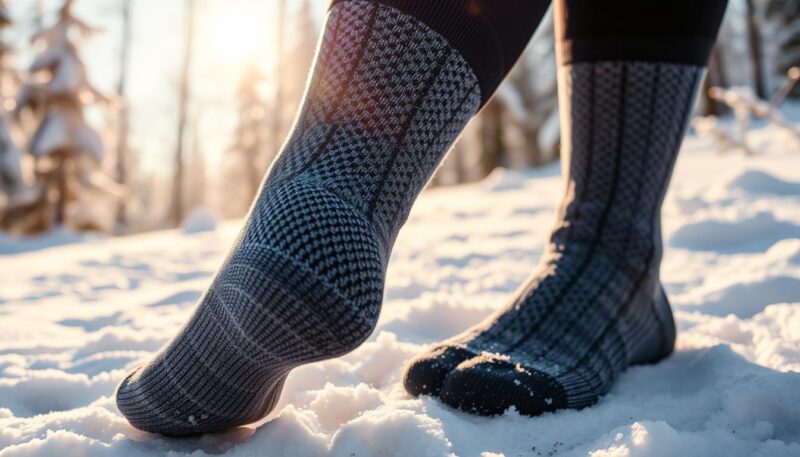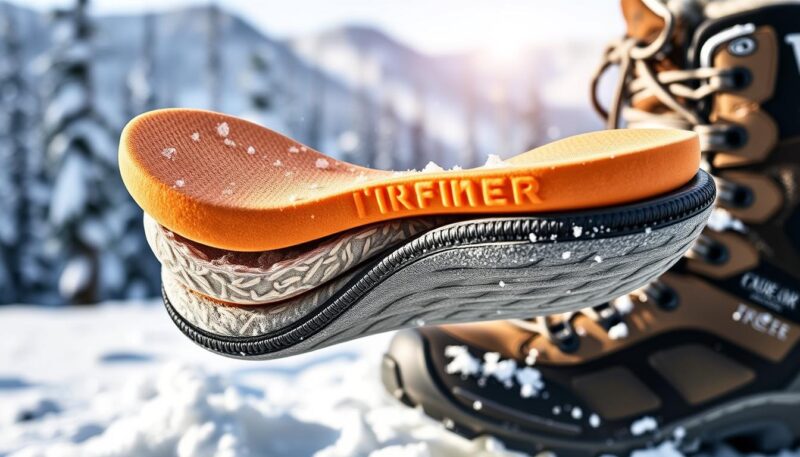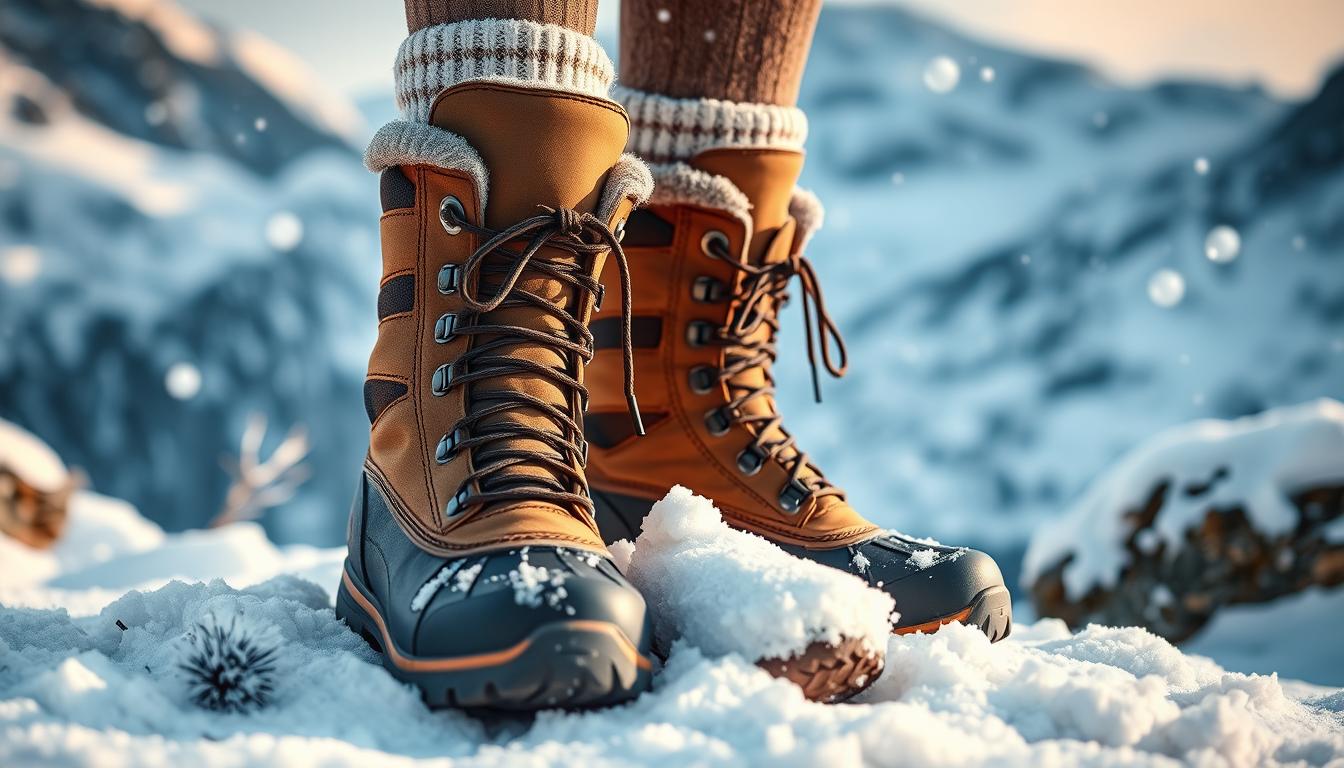When the beauty of winter landscapes calls your name, it’s tough to resist the allure of striking out on a great winter hike. However, one problem can become an instant hike-killer: cold feet. Winter hiking can be thoroughly enjoyable when your feet are warm and comfortable. In this section, we’ll delve into essential foot care tips for winter hikes to help you appreciate the frosty mornings and breathtaking snow-capped scenery without the distraction of freezing toes.
Exploring the great outdoors doesn’t have to be uncomfortable, even in the coldest months. A strategic approach to maintaining foot warmth can enhance your winter hiking experiences significantly. From choosing the right boots to ensuring proper foot hygiene and moisture management, taking care of your feet is paramount in frostbite prevention. Let’s embark on this journey to keep your feet warm during winter hikes and discover how to manage foot care effectively under chilly conditions.
Whether you’re navigating through Colorado’s snowy landscapes or trekking with groups like Explorer Chick on thrilling winter adventures, mastering these foot care tips can make a world of difference. Did you know that wearing a hat can conserve approximately 7-10% of your body heat? Additionally, keeping your feet dry is a fundamental factor in maintaining warmth during cold temperatures. Let’s dive into the strategies that will ensure your feet remain toasty warm on your next adventure.
Stay tuned as we unpack each aspect of winter hike foot care, from choosing the most suitable boots and socks to using foot care products effectively. By the end of this article, you’ll be equipped with the knowledge to keep your feet warm and dry, making your winter hiking experience not only bearable but thoroughly enjoyable.
With these foot care tips for winter hikes, minimize the risks of frostbite and transform your cold-weather trekking into an unforgettable experience. After all, having happy feet means more focus on soaking in nature’s winter wonders, snapping stunning photographs, and relishing the crisp, invigorating air.
Choosing the Right Boots
When it comes to ensuring warmth and comfort during your winter hikes, choosing the right boots is pivotal. This section will guide you through different types of footwear, ensuring your selection is both practical and efficient for the cold weather.
Insulated vs. Non-Insulated Boots
Deciding between insulated boots and non-insulated options can make a world of difference in maintaining foot warmth. Insulated boots, such as the Revel IV and Circadia Polar, feature lightweight insulation of 200g, effective for temperatures as low as -25°F/-32°C. If you seek superior thermal protection, the Revel IV High Polar boot with 400 grams of insulation might be your ideal choice. On the other hand, lightly insulated city/travel boots, like the Hood NXIS pull-on, offer around 100g of insulation, suitable for temperatures as low as -4°F/-20°C.
Waterproof Footwear
While insulated boots provide warmth, waterproof footwear ensures dryness, preventing cold from moisture infiltration. Brands like KEEN and their PFAS-free waterproof technology offer effective solutions. Waterproof boots can be submerged for prolonged periods, unlike water-resistant boots that only manage brief exposure. Proper maintenance, including applying oils, sprays, or waxes monthly, is essential for preserving the waterproof capabilities of these boots, especially for leather variants.
Boot Fitting for Cold Weather
Getting the right boot fitting is crucial to maintain blood circulation and warmth. Ensure your winter hiking boots are neither too tight nor too loose. Trying them on with the socks you intend to wear on hikes gives a more accurate fit. Boots that are too tight can inhibit blood flow, while those too loose might fail to insulate effectively. Additionally, boot height significantly impacts snow and ice protection, with hiking-centric models usually offering better coverage and support.
| Boot Type | Insulation Level | Temperature Range | Use Case |
|---|---|---|---|
| Revel IV and Circadia Polar | 200g | -25°F/-32°C | Hiking |
| Revel IV High Polar | 400g | Colder conditions | Extreme cold hikes |
| Hood NXIS | 100g | -4°F/-20°C | City/Travel |
| Greta Waterproof | 200g | -25°F/-32°C | Cold weather |
| Puffrider Snow Boot | 200g | -25°F/-32°C | Kids’ usage |
Essential Winter Hiking Socks
Staying warm during winter hikes requires careful attention to your choice of socks. The right pair of winter hiking socks can make all the difference by keeping your feet warm, dry, and comfortable.
Moisture-Wicking Materials
Choosing socks made from moisture-wicking materials is crucial. These materials help pull sweat away from your skin, keeping your feet dry and reducing the risk of cold and clammy feet. Opt for advanced thermal yarns used in synthetic socks, which can be up to seven times warmer than average cotton socks. Additionally, the antimicrobial properties in these socks help combat odor-causing bacteria, ensuring odor-free wear even after hours of activity.
Foot Layering Tips
Layering your socks strategically can significantly enhance warmth and comfort. Consider wearing a thin moisture-wicking liner sock underneath a thicker wool sock. This creates a double layer that traps warm air, further improving insulation. The thickness and layering of winter socks can trap more warm air around your feet, significantly boosting insulation. For high-intensity activities like skiing or snowboarding, thicker winter socks provide necessary cushioning and insulation, helping to maintain foot warmth and reduce the risk of injury.

Benefits of Merino Wool
Merino wool is an excellent material for winter hiking socks. It retains its insulating properties even when wet, making it ideal for winter activities where your feet may come into contact with snow or slush. The moisture-wicking properties of Merino wool pull moisture away from your skin, maintaining dryness and comfort. Moreover, Merino wool is hypoallergenic and naturally breathable, preventing bacteria and fungi growth. The unique structure of Merino wool allows it to regulate temperature, keeping your feet warm in cold weather and cool in warmer conditions. Brands like Heat Holders® emphasize the durability, comfort, and performance of their wool socks, making them a top choice for various outdoor activities.
| Features | Benefits |
|---|---|
| Moisture-Wicking Materials | Keeps feet dry, reduces odor |
| Foot Layering | Enhances warmth and insulation |
| Merino Wool | Retains heat, regulates temperature, hypoallergenic |
Foot Care Products for Warmth
Beyond boots and socks, other foot care products can enhance foot warmth effectively, ensuring you stay comfortable during your winter hikes. Let’s explore thermal insoles, chemical foot warmers, and moisture management strategies to keep your feet warm and dry.
Thermal Insoles

Thermal insoles are a fantastic addition to your winter foot gear. These insoles reflect heat back to your feet, providing an extra layer of warmth. Tread Labs Shearling Top Covers, for example, significantly improve insulation in cold conditions. By incorporating thermal insoles into your hiking boots, you’ll ensure that your feet remain warm even in freezing temperatures.
Chemical Foot Warmers
Chemical foot warmers offer immediate warmth and are incredibly convenient for active hikers. HotHands Toe Warmers, known to provide up to 8 hours of heat, are an excellent choice. They activate upon contact with air and offer a quick solution to cold feet. Whether you’re on a short hike or a longer winter expedition, having a pack of chemical foot warmers can make a significant difference in your comfort.
Moisture Management
Effective moisture management is crucial to keeping your feet warm. Wet feet lose their warmth quickly, so it’s essential to use foot care products that either absorb or repel moisture. For instance, layering an ultra-thin moisture-wicking sock beneath a thicker wool sock can enhance both moisture management and insulation. Merino wool socks, such as those from Alvada and Bombas, maintain their insulating properties even when wet, ensuring your feet stay warm and dry throughout your hike.
How to Keep Your Feet Warm and Dry
Keeping your feet warm during winter hikes starts with ensuring they remain dry. This involves understanding proper foot hygiene, strategies to avoid blisters, and maintaining dry feet.
Proper Foot Hygiene
Proper foot hygiene is critical in preventing moisture accumulation which can lead to cold feet. Regular cleaning and drying of your feet help in maintaining warmth. Using moisture-wicking products can effectively reduce skin moisture by up to 40%, preventing cold-related discomfort. Moreover, older adults often experience poor circulation, making their feet more vulnerable to cold; therefore, proper foot care is crucial.
Avoiding Blisters in Winter
Blisters can be exacerbated by wet conditions, making their prevention essential. Wearing improper socks, which affects about 40% of winter outdoor enthusiasts, often leads to cold, damp, and blistered feet. Layering with a thin wicking layer next to the skin and a thicker sock can increase warmth by up to 50%. Additionally, strategic use of foot powders or creams can help in reducing friction and moisture, thereby avoiding blisters in winter.
Keeping Feet Dry Strategies
Employing dry feet strategies is vital to combat the moisture that leads to cold feet. For instance, insulated footwear like those made with Gore-Tex or Thinsulate can significantly reduce cold discomfort. Ensuring proper boot fit is also essential as insufficient room for thermal socks can reduce foot circulation by up to 15%, affecting heat retention. Moreover, foot warmers, whether disposable or rechargeable, can provide necessary heat for several hours, enhancing performance in freezing temperatures.
Integrating these strategies into your winter hiking routine not only helps in keeping feet dry but also ensures warmth and comfort throughout your adventure. Pay attention to sock layering, proper footwear, and foot care products to effectively manage cold and moisture, and your feet will thank you.
Additional Tips for Warm Feet
Keeping your feet warm during winter hikes involves more than just wearing the right boots and socks. Here are some additional tips to ensure your feet stay warm and comfortable throughout your adventure:
Using Snow Gaiters
Snow gaiters are essential for protecting your feet from snow and wet conditions. They act as a barrier, preventing snow and moisture from getting into your boots. Integrating snow gaiters into your winter hiking gear can keep your feet dry, which is crucial for warmth. Combining them with waterproof footwear provides an extra layer of protection, ensuring you maintain warm feet even in harsh conditions.
Maintaining Foot Circulation
Maintaining foot circulation is vital for keeping your feet warm. Tight footwear or socks can restrict blood flow, leading to cold feet or even frostbite. It’s important to choose the right fit for both boots and socks to allow adequate circulation. Periodically moving your toes and walking at an easy pace initially can boost blood flow and help in maintaining foot circulation, especially in cold weather.
Preventing Frostbite on Feet
Preventing frostbite involves using the right gear and taking proactive measures during hikes. Ensuring that your boots are not too tight, using appropriate layering, and incorporating chemical toe warmers can significantly reduce the risk of frostbite. Periodic toe-wiggling and avoiding prolonged exposure to the cold are simple yet effective warm feet tips to prevent frostbite.
By following these additional tips, you can enhance your foot warmth and enjoy your winter hiking adventures with greater comfort and safety.
| Method | Benefit | Cost |
|---|---|---|
| Snow Gaiters | Prevents snow and moisture from entering boots | $20-$50 |
| Proper Footwear Fit | Maintains foot circulation and comfort | Varies |
| Chemical Toe Warmers | Provides up to 6 hours of heat | $1-$3 per pair |
Conclusion
As you embark on your winter hiking adventures, the knowledge gained from this article is invaluable to your preparation strategy. Selecting the right boots and socks is not just about fashion; it’s about equipping yourself with the best defenses against cold weather. Choosing waterproof, insulated boots ensures your feet remain dry and warm, while merino wool socks offer excellent moisture-wicking properties and thermal regulation. Thermal insoles and chemical foot warmers add an extra layer of protection, further keeping the cold at bay.
Foot warmth strategies encompass more than just the right gear. Proper hygiene routines, moisture management, and avoiding blisters are critical to maintaining comfort during winter hikes. Healthy feet are warm feet, and strategies such as keeping feet dry, regular washing, and wearing breathable socks play a large role in preventing cold-related issues. The risk of frostbite, reduced circulation, and other cold-induced ailments can be significantly mitigated through these simple yet effective practices.
Packing extra layers, using snow gaiters, and ensuring good foot circulation by staying active and taking breaks can also enhance your overall hiking experience. Winter hiking preparation does not end with gear and foot care products; it is an ongoing process of mindfulness on the trail. By adhering to these safe hiking practices, you can enjoy the serene beauty of winter landscapes without compromising your well-being. The comprehensive foot warmth strategies outlined here empower you to tackle the cold with confidence, ensuring every winter hike is a safe and enjoyable one.

